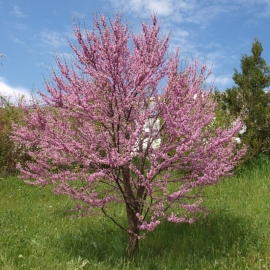


Organic Cercis European Seeds (Cercis siliquastrum)
3.00 €
A highly branched tree or shrub with a wide crown, with reddish branches and heart-shaped, green leaves, at the time of flowering, completely refute the specific name of extraordinary bright beauty.
-
Cercis European (Cercis siliquastrum)
A highly branched tree or shrub with a broad crown, reddish branches and heart-shaped, green leaves. At the time of flowering, the species name is completely refuted by its extraordinary bright beauty.
Biological description:
The scarlet blooms before the foliage blooms, it does not bloom for long - 3-4 weeks. But there are so many flowers that thin shoots, thick skeletal branches, and even a trunk are covered with them. Small flowers of the moth type, like most legumes, are collected in bunches, bunches - in lush "caps". The development of leafless inflorescences on old branches and trunks is typical for most tropical plants, but among subtropical species this is a rare phenomenon. A similar phenomenon is called "caulifloria" (from the Greek kaulos - stem, trunk and Latin flos, parent. Case floris - flower).
Leaves are rounded or broadly oval bloom at the end of flowering, young foliage has a pink-brown tint, then the top becomes dark green, and the bottom becomes bluish-blue. In September, hard brown pods begin to rustle merrily in the wind in the crown of the tree. Small seeds have tiny lionfish; they are light: in 1 kg - up to 2 million pieces. In nature, it grows on rocky slopes, tolerates drought well.
Agrotechnics:
The purple root is capable of propagating by cuttings (60% rooting). Cutting technology is the same as for many trees and shrubs. Cuttings 12-15 cm long with two internodes are cut in late June - early July. They take root in a summer greenhouse at a temperature of 22-25 ° C and high humidity. When planting a tree in a permanent place, it needs to create good lighting, given that, on the other hand, young two-three-year-old seedlings have a risk of sunburn in the bark in the spring in too bright sun.
The plant thrives best in moist, fertile soil. The optimum soil acidity is slightly acidic or closer to neutral (pH 5.5–6), but purple can grow on both highly acidic and alkaline soils. As a rule, the acidic reaction of the soil provides a richer autumn color of the foliage. The minimum groundwater level is no closer than 2 m.
Young plants require pruning for lateral growth. Adults prune as needed or do not prune at all, as the plant grows rather slowly.
Application:
The scarlet is used as an ornamental deciduous breed, and its name indicates the bright hue of the heart-shaped leaves. The color is most vividly manifested in the fall, when the plant is colored with yellow and crimson paints and looks really great. Very bright carmine-brown shoots and leaf stalks give it a special color.
The tall purple rose with a beautifully dense crown is the ideal specimen tree. In group plantings, it often sets the basic tone. At the foot of the scarlet, spreading, low-growing shrubs are often grown. An ideal background for a plant is evergreen, on which its bright autumn foliage looks good.
Mainly grown as an ornamental plant. Light and soft wood with an unusual texture is often used as a building material and for making furniture.
The name can be pronounced as: Carob scarlet, European scarlet, European Cercis, Carob Cercis, Pod-bearing Cercis, Judas tree, Cercis
